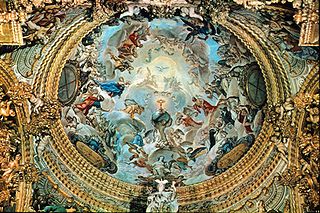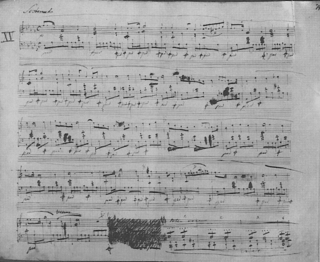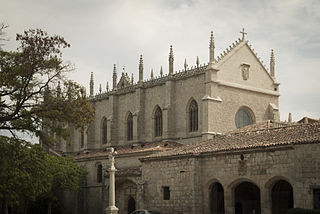
Mallorca, or Majorca, is the largest island of the Balearic Islands, which are part of Spain, and the seventh largest island in the Mediterranean Sea.

Bellver Castle is a Gothic-style castle on a hill 3 km to the west of the center of Palma on the Island of Majorca, Balearic Islands, Spain. It was built in the 14th century for King James II of Majorca, and is one of the few circular castles in Europe. First serving as the residence of the Kings of Majorca, and afterward long used as a military prison throughout the 18th to mid-20th century, it is now under civilian control, being one of the main tourist attractions of the island, as well as the seat for the city's History Museum.

Sancho, called the Pacific or the Peaceful, was King of Majorca, Count of Roussillon and Cerdanya, and Lord of Montpellier from 1311 to his death. His 13-year-long reign was markedly undisturbed by turmoil, which earned him his epithets, and is thus often contrasted to the troublesome reigns of his father, James II, and nephew, James III, his predecessor and successor respectively.

Granada Charterhouse is a Carthusian monastery in Granada, Spain. It is one of the finest examples of Spanish Baroque architecture.

The Monasterio de Santa María de El Paular is a former Carthusian monastery located just northwest of Madrid, in the town of Rascafría, located in the Valley of Lozoya below the Sierra de Guadarrama.
The Charterhouse of Aula Dei is a Carthusian monastery, or charterhouse, located about 10 kilometers north of the city of Zaragoza in Aragon, north-eastern Spain. It was declared a national monument on 16 February 1983.

The Monastery of Santa María de las Cuevas, also known as the Monastery of the Cartuja (Charterhouse), is a religious building on the Isla de La Cartuja in Seville, southern Spain. The Andalusian Contemporary Art Center (The Centro Andaluz de Arte Contemporáneo (CAAC)) is now located on this site.

The Frescoes in the Cartuja de Aula Dei (1774) are a cycle of frescoes or mural paintings on the Life of the Virgin by Francisco de Goya, realised in secco, in the church of the Charterhouse of Aula Dei near Peñaflor de Gállego on the outskirts of Zaragoza, Aragon, Spain.

The Prelude Op. 28, No. 15, by Frédéric Chopin, known as the "Raindrop" prelude, is one of the 24 Chopin preludes. It is one of Chopin's most famous works. Usually lasting between five and seven minutes, this is the longest of the preludes. The prelude is noted for its repeating A♭, which appears throughout the piece and sounds like raindrops to many listeners.

Miraflores Charterhouse is an Isabelline style charterhouse, or Carthusian monastery of the Order of the Carthusians, built on a hill about three kilometres from the center of the Spanish city of Burgos, autonomous community of Castile and León.

The following is a compilation of memorials to the composer Frédéric Chopin in the form of physical monuments and institutions and other entities named after him.

San José Charterhouse is a Carthusian monastery dedicated to Saint Joseph which is located in the city of Deán Funes, Córdoba in Argentina. It is the third Carthusian monastery in the Americas and the second in Latin America.

A Winter in Majorca is an autobiographical travel novel written by George Sand, at the time in a relationship with Frédéric Chopin. Although published in 1842, it appeared for the first time in 1841 in the Revue des deux Mondes.

The Ara Christi Charterhouse, or the Cartuja de Ara Christi, is a former Carthusian monastery located just outside the town of El Puig in the province of Valencia, Spain. The site now includes a hotel and utilizes the facilities for functions.

Porta Coeli Charterhouse, Cartuja de Porta Coeli or Cartuja Santa María de Porta Coeli, is a functioning Carthusian monastery located on a rural site of the municipality of Serra de Porta Coeli in the province of Valencia, Spain. The name of the charterhouse, Porta Coeli, means door of heaven.

Friar Manuel Bayeu y Subías was a Spanish painter, architect and Carthusian monk.

Joaquim Juncosa was a Spanish Baroque painter and monk of the Carthusian order at the monastery of Scala Dei.

Cartoixa d'Escaladei, or Chapterhouse of Scala Dei, was a monastery of the Carthusian order in the southern Catalonia. It was founded in the 12th century, was an important centre for art in the 17th century and started the planting of vines in the region that became later known as Priorat due to the vineyards of the monks.






















